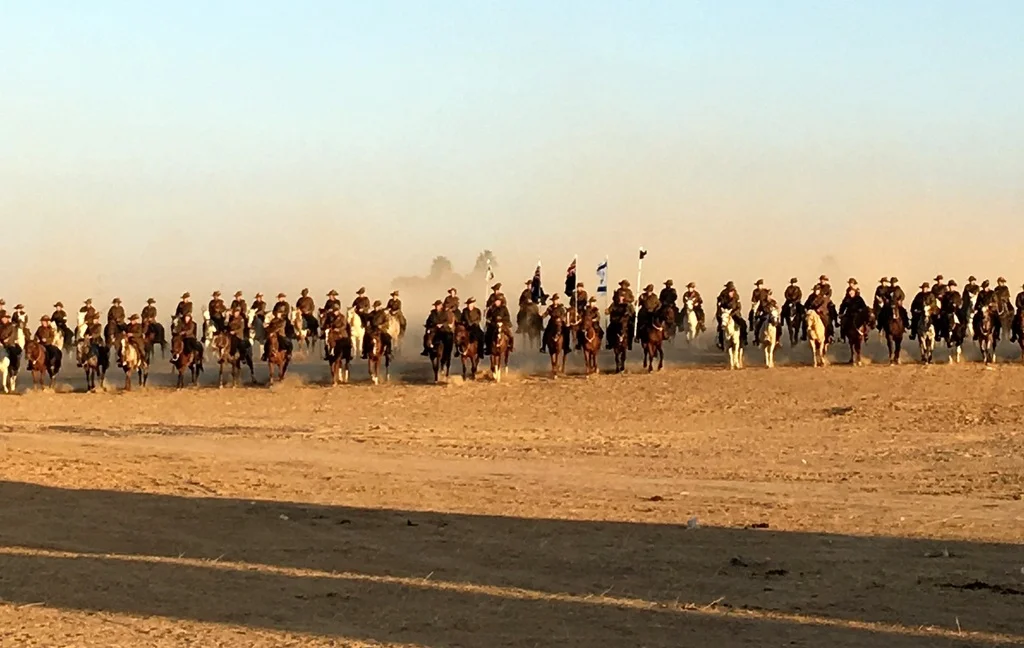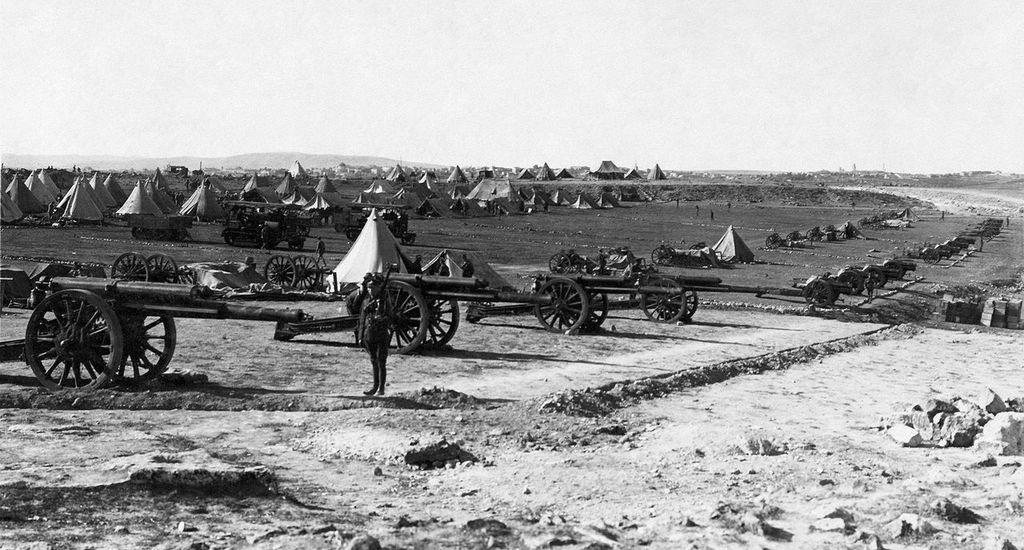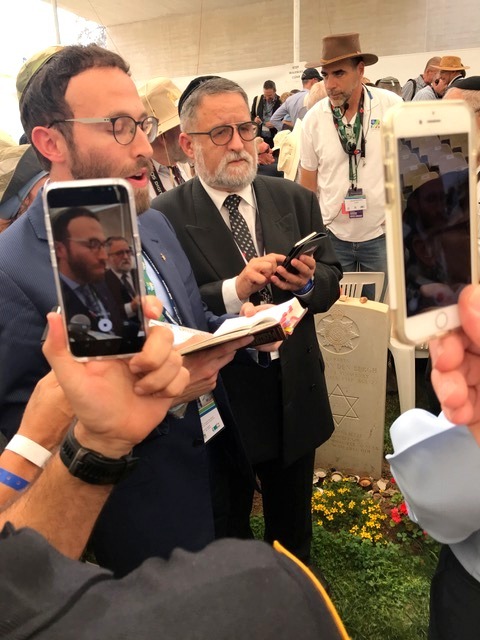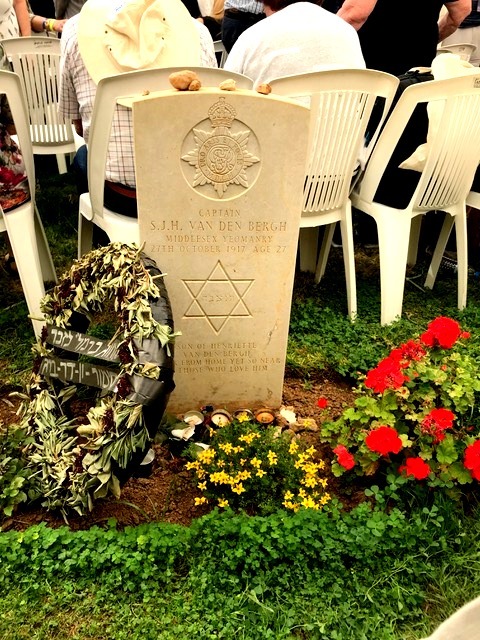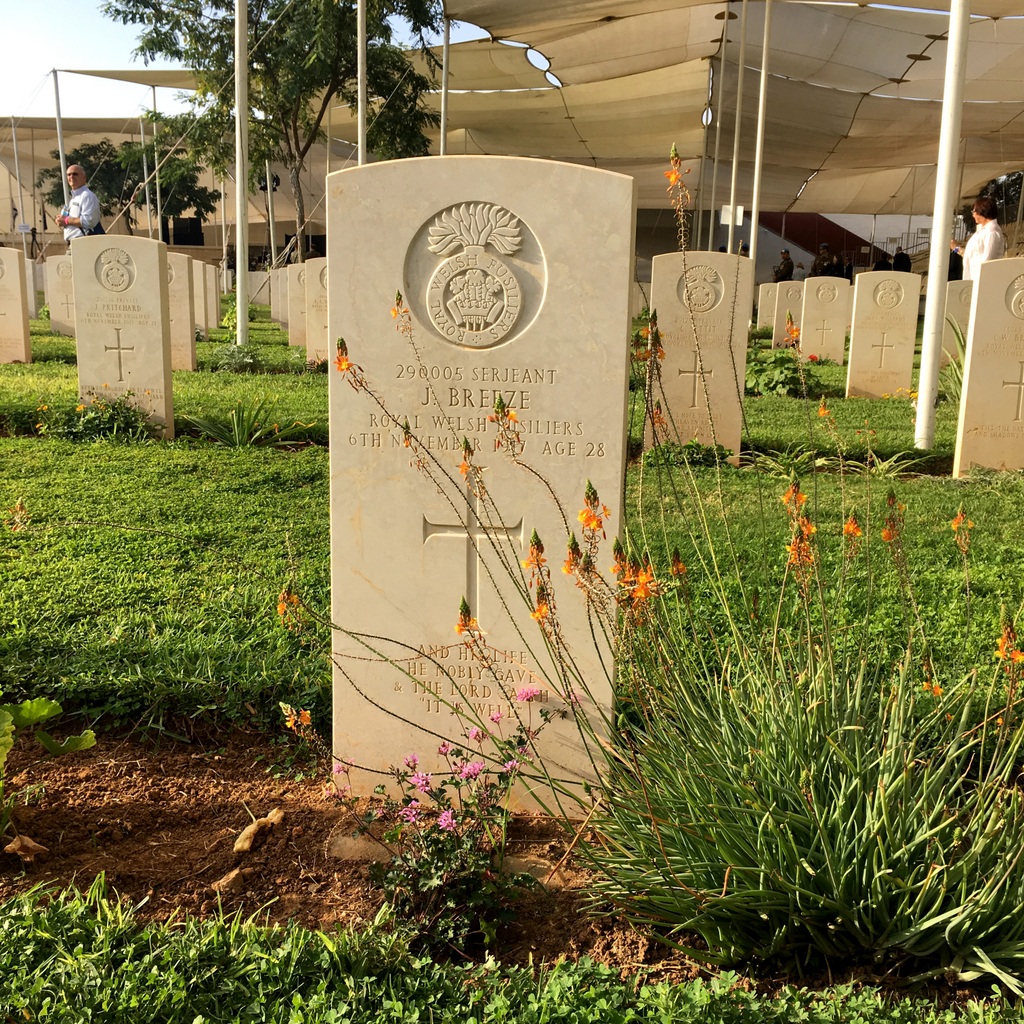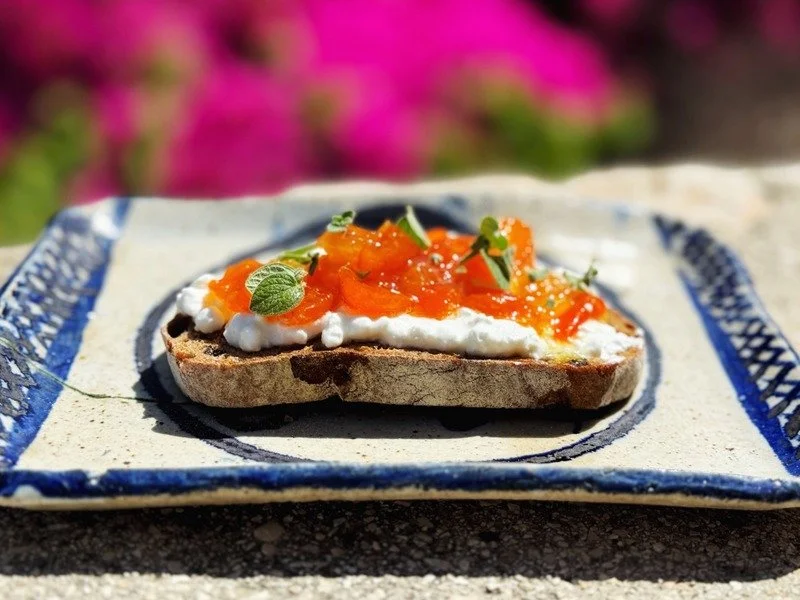HISTORIC + SUGAR-FREE
Warm jewel bright autumn days continue to be a pleasure, but there hasn’t much time for cooking in a busy - strange - news week, where both the main stories were 100 years old! Yes, the centenaries of the Balfour Declaration and Battle of Beersheba were back on the bulletin, with Beersheba definitely the winner - an Australian story with veterans, prime ministers, and best of all horses!
The 4th and 12th Australian Light Horse and the descendants of the soldiers who fought here 100 years ago, ride through the streets of Beersheba, as part of the Centennary celebrations.
A Melbourne reader has reached out to ask me fore a recipe for a vegan honey cake. I counter-offered with an almost vegan zucchini and blueberry bread. It is sugar and dairy free, and one of the best of this type of things - not easy or promising - that I have baked yet. Recipe below.
MY KINGDOM FOR A HORSE
Earlier this year, when Israeli Prime Minister Benjamin Netanyahu visited Sydney, Australia’s PM Malcolm Turnbull announced he would lead the Aussie contingent to Israel, to commemorate the 1917 Battle of Beersheba. The Battle was a turning point in World War One, fought and won by Australian and NZ troops, with a famous Cavalry charge.
“I have to come – Bibi’s promised everyone a horse!” Turnbull said. That got a laugh, but the Australian commemoration did include a re-enactment of the Charge...
1917 Cavalry Charge, re-enacted on the 100th anniversary, 31 October 2017
Still, Turnbull almost didn’t make it. There was a political crisis when it looked like he was losing his majority in the parliament, as various Coalition MPs turned out not to be Australians after all (Oops…)
In the end he did come, and that led me to a personal first: travelling with the journalists who travel with the PM.
Australian PM Malcolm Turnbull and Israeli PM among the dignitaries laying wreaths at the Military Cemetery in Beesheba (Getty Images.)
Down to Beersheba in the bus we all went, for what turned out to be a very emotional day, where every single person I interviewed burst into tears!
HISTORY
Australia was a young country in 1914 when World War One began. It was still tightly connected to Britain despite its 1901 vote to create the Commonwealth of Australia. Australians fought for Britain in huge numbers. Out of a population of 5 million, 440,000 enlisted. That’s almost 10 per cent of the total population!! Of the enlistment age men, it’s much higher. It goes part of the way to explaining the grip World War One still has on the Australian imagination, and why this Commemoration was so moving.
In the Middle East, the Australians and New Zealanders were fighting against 'the Turks' - in fact, soldiers from across the Ottoman Empire, led by German officers. Many of the people who came to pay their respects at the Beersheba Military cemetery have the medals of German officers who surrendered to their fathers or grandfathers.
Ottomans recruiting for the 'Holy War' in Tiberias, in 1914. Tiberias is in present day Israel and this hows how locals across the Middle East fought on the Turkish side. (Ameican Colony collection)
The Light Horse, training in Australia, before World War One. (Australian Light Horse)
Here are the stories of 3 people who came to pay their respects at the Beersheba Military Cemetery, where 1,239 Australian soldiers lie buried. The majority were country boys, good with horses. The Light Horse did a lot of its recruiting in Victoria, and that’s where most of the soldiers and their descendants I interviewed were from. They were wonderful, salt of the earth Australians, and I was lucky to spend time with them.
BRIAN CANTWELL
77 year old Brian Cantwell from Sale in Victoria has a ready grin, and a great turn of phrase. In the early morning light at the Cemetery, his chest gleams with medals. He worked as an electrician, and was also in local politics – he was deputy mayor of Sale - and the medals belong to his father, Sergeant John Cantwell of the 4th Light Horse.
“Dad was a sniper at Lone Pine and he survived that,” says Brian.
It turns out that like many of the men who fought at Beersheba, John Cantwell had previously been at Gallipoli, the devastating and pointless 1915 battle with the Turks, where more than 8,000 Australians died and almost 20,000 were wounded.
Australian sniper in a trench at Lone Pine, Gallipoli. This was John Cantwell's task in the same spot. He survived this battle, and was redeployed to Suez and then fought in the 1917 Battle of Beersheba.
“Then they spent 18 months guarding the Suez canal before fighting their way up through the Sinai to reach Gaza and then Beersheba.”
On the afternoon of 31 October 1917, 800 men of the 4th and 12th Light Horse brigades, lined up for a Cavalry charge.
Men battled each other on horseback for centuries. But WWI was fought after the invention of the car. War was becoming mechanised. The Cavalry Charge at Beersheba was one of the last in history. It was late afternoon. The horses were thirsty and had to race into the sun. The men had their rifles slung across their backs, and their bayonets in their hands as they prepared to charge Turkish troops, who were armed, of course, and protected by trenches.
“My father was the Sergeant of H squadron, he had no choice he was in in the front 6, the lead in the Charge,” Bryan says. “He survived. Most of them did. They lay along the horses’ necks. Many horses were killed, but the men were pretty good survivors. They were courageous and we’re here to remember them.”
But the remembering also prompts tears.
“I am so emotional. You can feel it here. They did it for their mates, they did it for us. And for their children’s children. They paid a price,” he pauses, unable to stop the flow of tears. “It’s bloody awful. My old man would kick me up the bum for being so weak,” he smiles.
Brian Cantwell, left, the son of Sgt John Cantwell, who was decorated for his part in the Cavalary charge at Beersheba. Brian is wearing his father's medals. David Reed, right, is also here to pay his respects.
LACHLAN MACDONALD
Lachlan Macdonald lives on a farm in south western Victoria, near Coloraine. It’s the same farm that his grandfather Malcolm MacDonald bought in 1922, under the Soldier Settlement scheme. (As the Light Horse had recruited in Victoria, that was one of the places they offered the returned servicemen land after the War.)
“I’m very proud to be on the same land. There are only 2 others in our district where the land is still in the family. I run a rural equipment business – but also do a bit of farming too,” says Lachlan MacDonald.
This photograph is the only one we have of the Charge. It was supposedly taken by a Turkish soldier who was then captured along with his camera.
MALCOM MCDONALD
Malcolm Macdonald was 23 when he signed up in September 1914, just one month after the war began.
“He was very proud of being one of the “originals” and his low number – 801. He was shipped out and was fighting at Gallipoli in 2015. As a Light Horse, he was dismounted so he could fight there,” Lachlan explains.
After Gallipoli, the surviving Light Horse troops, were re-deployed to the Suez canal. In 1917, they rode and fought their way up through the Sinai dessert to Beersheba.
“On 31 October 1917, my grandfather was in B troop, A battalion right at the front of the Charge,” Lachlan says.
FIRST PERSON
The MacDonalds have their grandfather’s service medals and his letters home, often written in pencil. In a wonderfully modern contrast, Lachlan has the letters on his smartphone. He reads aloud.
25 November 1917
Dear Mother,
Just a few lines to let you know that I am quite well and hope you are the same.
There was no mailout after we took Beersheba. Our squadron galloped into action under a hail of bullets. You couldn’t imagine it, unless you actually saw it. We were supposed to dismount for action, but we galloped straight on in to the Turkish rideouts and of course the shock was all too much for the Jacko (Turks) and most of the lads went on and took the town. I myself and a few others remained dismounted because our horses were shot. In the next section to the left of me 3 men were killed, and another was wounded.”
There was also the harsh reality of dealing with their wounded horses.
“His horse got bayoneted going over the trenches, and after close hand to hand fighting, you’d have to deal with your horse. Yeah, it’s sad. He would have had to kill his own horse, if it hadn’t already died, after the main threat.”
Lachlan’s voice trembles as he reflects on what he has just read.
“Three of the men riding beside him were killed in this Charge. It only needed a bullet this far away, and his line of descendants wouldn’t be here. It’s luck. Sheer luck.”
CHRIS NIEWALD
Chris lives with her husband on a farm near Minyip in Victoria, where they film the Flying Doctor series, Cooper’s Crossing.
She is here to visit the grave of her great-uncle Harold Bell, who was just 16 years old when he took part in the Cavalry Charge.
“He’d had a fight with his father on the family farm in Victoria. He was angry about something and took off and enlisted. They didn’t know, they thought he’d gone off to be a jackaroo,” says Chris. “He was very young and very determined, and very good with horses.”
Harold enlisted under his mother’s maiden name, as Harold Wickham, so the army wouldn’t know he was under the enlistment age of 18. He shipped out in June 2017, and was shot a few months later, here at the Battle of Beersheba.
“He was shot in the leg and died the next day of his injuries,” says Chris.
Harold Bell was one of 32 Australians who died fighting at Beersheba. He was still just 16 years old.
The suffering for the family didn’t end there. Harold’s brother Sam was fighting on the Western front, and was killed in August 2018 – 3 months before the end of the War.
“Sam didn’t make it home either. What made it worse was that he died as a result of friendly fire. Apparently when they came to tell them that Sam had also died, my great-grandmother collapsed. The family was devastated to lose 2 sons in the War.”
Chris says she’s honoured to be here, representing all the Bell descendants and to lay a wreath for Harold.
“It must have been very hard on my family and all the others too who lost sons, brothers, fathers and had them die in foreign soil, and some were never able to visit their graves.”
CLEAVER
Before the formal Commemoration ceremony begins, Brian Cantwell searches for the grave of one of his father’s friends from the 4th Light Horse.
“His name was Cleaver and he was a butcher. He was the first man from Sale to enlist,” says Brian.
We find an Australian official with a map of the cemetery who can tell us where to look. “Cleaver, Edmond Randolph? That’s D-38."
When we locate the neatly tended grave, Brian is visibly moved.
“Ed Cleaver was an only son. By mid-1917, his father was dying and he asked for compassionate leave, but he was knocked back. He was injured in the Charge, and died a few days later. His father died the same day, it was an absolute tragedy. There are no Cleavers left, and I’m just here acknowledging him. I didn’t know him, but I feel part of him. The atmosphere here today is electric. All the people here, they’re all genuine. And everyone’s got a story too.”
REFLECTIONS
“Not many things that bring tears and emotions more than something like this – WWI, WWII, Vietnam. I just don’t know what it is that turns me into nappies,” says Lachlan Macdonald, laughing. “As well as paying my respects, being here is also expressing gratitude.”
Lachlan says his grandfather Malcom’s letters reveal his changing feelings about War.
“He was full of enthusiasm at first. And he wrote that they should get the town’s ‘no hopers’ over, it would straighten them out. But by the end he is writing to his mother about his younger brothers and he says, ‘Tell Huey and Jack not to come.’ He didn’t think they had the fortitude.”
Lachlan is aware of the same feelings. “I see my friends here with their sons, or I think of boys in my family and in my mind I think there’s no way known they could handle it. But I suppose every father and son says the same. They had to step up or you didn’t come home.”
Many of the Light Horse soldiers were indigenous Australians. They were not yet citizens in 1917, but were taken to be soldiers, to fight and die for Australia and the Empire. Dr David Henderson lays a wreath on behalf of all indigenous soldiers.
turning point
Brian Cantwell’s father was decorated for his courage during the Battle of Beersheba.
“Dad and 4 of his troop, they all got medals. A German officer, the Turks were led by Germans, he saw Dad was the Sergeant so he handed him his pistol when he surrendered. Those 4 or 5 men captured 200 troops.”
Turkish prisoners being led by the Australian Light Horse, 1917. (Australian War Memorial.)
Beersheba was a turning point.
Within 2 months, ANZAC troops were part of the force that took Jerusalem before fighting their way up to Damascus. After the ANZAC troops had secured the Old City, British General Edmumd Allenby entered the Jaffa Gate on foot, to show respect to the holy city. He was the first non-Muslim in more than six centuries to control Jerusalem, and the December conquest served as a psychological boost in the UK. Prime Minister Lloyd George described it as "a Christmas present for the British people".
British artillery during the Battle for Jerusalem.
“My father did say years later they made history at Beersheba, and they knew it,” says Brian Cantwell. “It was the first turning point of the War. The commanders reported back to London on November 1st, and it was the first significant victory that the Allies had had. A lot of that has to do with the Australians and New Zealanders,” he says proudly
Australian Light Horse, Jerusalem 1917. Within 2 months of the Battle of Beersheba, Jerusalem fell to British and ANZAC troops.
respect
As Chris Niewald lays a wreath for her great-uncle, who enlisted and died aged 16, she says she feels overwhelmed by the number of graves here.
“It’s something I’ve always wanted to do, and it’s amazing to be here. But to lose so many of our young men, it is incredible to see. Still, I think this story should be better known. We should learn about Gallipoli, of course, but also more about this. Our men came up here and probably beat the same men they’d lost to at Gallipoli. Gallipoli was a British led defeat. Beersheba was an Aussie led victory. On ANZAC day, we should also celebrate our victories,” says Chris.
Jewish veteran
An old family friend Peter Halas attended the Beersheba ceremony and stood by the grave of British soldier Captain S Van Den Burgh. He'd served in the British Middlsex Yeomanry and died aged 27, the only Jewish soldier buried here. Peter was part of the group who joined the Captain's descendants in saying the Kaddish, the Jewish mourner's prayer, at his grave.
THE CAVALRY CHARGE RE-ENACTMENT
Some 3,000 Australians and New Zealanders came to the Beersheba service and to watch the charge.
Media, casting long shadows in the waning afternoon light, as we wait for the Charge.
It was a fun - very dusty - day for me as well!
grandchildren
The returning WWI veterans didn’t talk much to their children about the difficult things they had seen – and done. At Beersheba I learned something I’ve observed doing interviews for the Food is Love project: many of the men were prepared to open up more to their grandchildren.
“I only learned the name of my father’s horse from one of the grandchildren. It was Lightning, but he never told me that. He would share the funny stories, but not the serious ones,” says Brian Cantwell.
As he tells some of those funny stories, Cantwell says he’s lived a good life – and he knows who to thank for that.
“These men, they made it possible. I’ve had a wonderful 77 years, it’s been fantastic because these men made Australia great. Lest we forget,” says Brian.
RECIPE
Here is something you can pack into your old kit bag and take on a picnic. Or just enjoy eating at home, good for afternoon tea or breakfast. This Blueberry and Zucchini bread is surprisingly delicious given how healthy it is :-) The recipe was originally vegan, but it used fake eggs, which like fake news, make me nervous. (What’s in them???) So I'm using real eggs. Here is the original vegan version which uses sugar and honey. (Is honey vegan?)
I'm more interested in trying to go sugar free, which at present means no honey, maple syrup, silan, agave or rice malt syrup. Dextrose ( also sometimes called grape sugar) is the answer! It is white and looks like icing sugar - or cocaine - but absorbs more liquid than sugar, which is something you have to take into account when figuring quantities for baking.
Confession: this is the first healthy baked good I’ve made with dextrose which is actually edible. It's sweet, moist and super-flavorful. Let me know if you succeed too.
Healthy Blueberry Zucchini Bread
Makes 2 loaves, about 20 slices
Ingredients
- 3 eggs
- 1 ¼ cup unsweetened applesauce
- 2 teaspoons vanilla essence or 1 heaped teaspoon vanilla bean paste
- 1 ¼ cups dextrose (grape sugar)
- zest and juice of 1 lemon
- 3 cups zucchini, grated - about 2 large zucchini
- 3 cups spelt flour or wholemeal wheat flour
- 1 teaspoon salt
- 2 teaspoons baking powder
- 1/2 teaspoon baking soda
- 1 tablespoon cinnamon
- dash nutmeg
- 2 cups blueberries, frozen
OPTIONAL TOPPING
- ½ cup oats
- ¼ cup dextrose ( grape sugar)
- 1 teaspoon cinnamon
- ¼ cup applesauce
Method
1. Heat oven to 180/350 degrees. Ten degrees less if your oven is fan-forced. Grease and flour two pans. The original recipe called for 2 loaf pans. I made one loaf pan and one small round pan, 8 inch / 20 cm.
2. Grate zucchini. Main question: to squeeze or not to squeeze? Many zucchini bread recipes tell you *not* to squeeze the excess moisture out of the zucchini. And since dextrose absorbs liquid, that works best here too. But if you are not using dextrose, just ordinary sugar or honey etc, then do squeeze out the zucchini. You don’t need so much moisture in this bread.
3. In a large bowl, beat together the eggs, applesauce, vanilla, dextrose/grape sugar and lemon juice and zest. Fold in the zucchini.
4. In a medium bowl, whisk together the flour, salt, baking powder, baking soda, cinnamon and nutmeg.
5. Gradually stir the dry ingredients into the wet until well combined. Fold in the blueberries. These are best frozen, since they won’t break up and turn everything purple/grey. You can use other berries if you prefer.
6. Divide the batter between the pans and spread evenly.
7. If you are making the topping – I didn’t - mix the ingredients together and sprinkle over the batter in the pans.
8. Bake 1 hour and 20 minutes. Lay a sheet of foil over the pans during the last 20 minutes to prevent them from browning too much.
